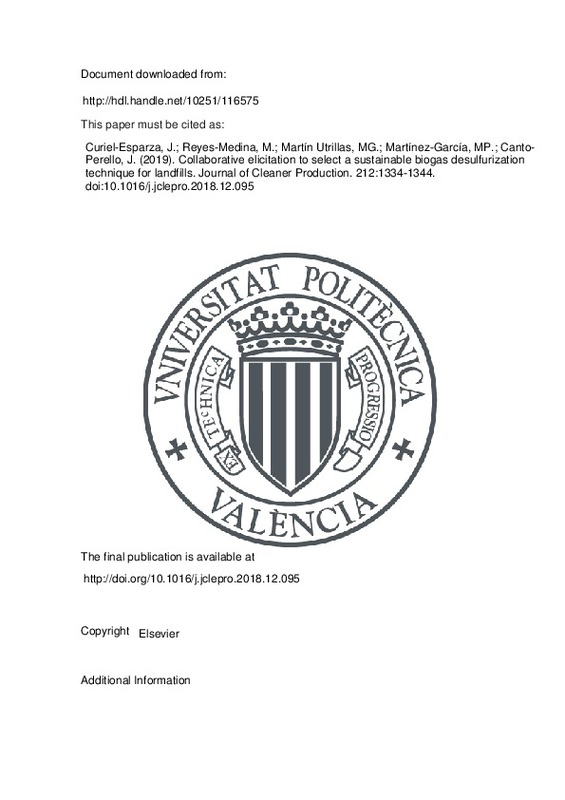JavaScript is disabled for your browser. Some features of this site may not work without it.
Buscar en RiuNet
Listar
Mi cuenta
Estadísticas
Ayuda RiuNet
Admin. UPV
Collaborative elicitation to select a sustainable biogas desulfurization technique for landfills
Mostrar el registro sencillo del ítem
Ficheros en el ítem
| dc.contributor.author | Curiel-Esparza, Jorge
|
es_ES |
| dc.contributor.author | Reyes-Medina, Manuel
|
es_ES |
| dc.contributor.author | Martín Utrillas, Manuel Guzmán
|
es_ES |
| dc.contributor.author | Martínez-García, María Peña
|
es_ES |
| dc.contributor.author | Canto-Perello, Julian
|
es_ES |
| dc.date.accessioned | 2019-02-08T21:04:38Z | |
| dc.date.available | 2019-02-08T21:04:38Z | |
| dc.date.issued | 2019 | es_ES |
| dc.identifier.issn | 0959-6526 | es_ES |
| dc.identifier.uri | http://hdl.handle.net/10251/116575 | |
| dc.description.abstract | [EN] The 2015 Paris Agreement within the United Nations Framework Convention on Climate Change establishes three key ways for the reduction of the emissions of Greenhouse Effect Gases: mitigation, adaptation and resilience of ecosystems. In this context, one of the major goals for methane recovery from waste is the process of obtaining biogas from biomass or waste, a form of fuel with zero impact on the carbon footprint of the planet. All possible uses of biogas depend mainly on the degree of purification obtained. The removal of hydrogen sulfide (H2S) is the main weakness in using biogas in industrial applications. If the use of biogas is intended for engines, turbines or to enrich the biogas to obtain natural gas, lowering the levels of H2S will be necessary, in order to avoid corrosion in gas lines and in engines. Biogas desulfurization can be achieved through different techniques: physical, chemical, biological or hybrid procedures. Selecting the most sustainable technique to clean biogas entails a complex problem, which involves the analysis of these desulfurization treatments under different criteria. In this paper, we present a novel collaborative elicitation to select the consensus procedure for the reduction of the concentration of H2S in biogases from landfills. The elicitation technique is based on fuzzy set theory and VIKOR method in order to handle intangible data and to avoid potential bias by the panelists. The proposed hybrid method guarantees traceability and transparency to achieve consensus among the panel of experts during the decision making procedure. | es_ES |
| dc.language | Inglés | es_ES |
| dc.publisher | Elsevier | es_ES |
| dc.relation.ispartof | Journal of Cleaner Production | es_ES |
| dc.rights | Reconocimiento - No comercial - Sin obra derivada (by-nc-nd) | es_ES |
| dc.subject | Landfill biogas | es_ES |
| dc.subject | Desulfurization technique | es_ES |
| dc.subject | Collaborative elicitation | es_ES |
| dc.subject | Fuzzy set | es_ES |
| dc.subject | VIKOR method | es_ES |
| dc.subject.classification | FISICA APLICADA | es_ES |
| dc.subject.classification | INGENIERIA DE LA CONSTRUCCION | es_ES |
| dc.title | Collaborative elicitation to select a sustainable biogas desulfurization technique for landfills | es_ES |
| dc.type | Artículo | es_ES |
| dc.identifier.doi | 10.1016/j.jclepro.2018.12.095 | es_ES |
| dc.rights.accessRights | Abierto | es_ES |
| dc.contributor.affiliation | Universitat Politècnica de València. Departamento de Ingeniería de la Construcción y de Proyectos de Ingeniería Civil - Departament d'Enginyeria de la Construcció i de Projectes d'Enginyeria Civil | es_ES |
| dc.contributor.affiliation | Universitat Politècnica de València. Departamento de Física Aplicada - Departament de Física Aplicada | es_ES |
| dc.description.bibliographicCitation | Curiel-Esparza, J.; Reyes-Medina, M.; Martín Utrillas, MG.; Martínez-García, MP.; Canto-Perello, J. (2019). Collaborative elicitation to select a sustainable biogas desulfurization technique for landfills. Journal of Cleaner Production. 212:1334-1344. doi:10.1016/j.jclepro.2018.12.095 | es_ES |
| dc.description.accrualMethod | S | es_ES |
| dc.relation.publisherversion | http://doi.org/10.1016/j.jclepro.2018.12.095 | es_ES |
| dc.description.upvformatpinicio | 1334 | es_ES |
| dc.description.upvformatpfin | 1344 | es_ES |
| dc.type.version | info:eu-repo/semantics/publishedVersion | es_ES |
| dc.description.volume | 212 | es_ES |
| dc.relation.pasarela | S\377179 | es_ES |







![[Cerrado]](/themes/UPV/images/candado.png)

